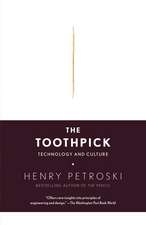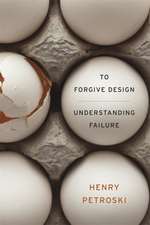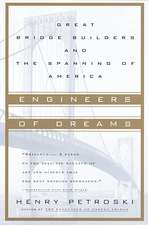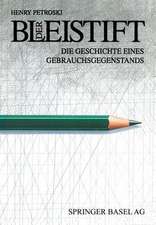Small Things Considered: Why There Is No Perfect Design
Autor Henry Petroskien Limba Engleză Paperback – 31 aug 2004
To illustrate his thesis, Petroski tells the story of the paper drinking cup, which owes its popularity to the discovery that water glasses could carry germs. He pays tribute to the little plastic tripod that keeps pizza from sticking to the box and analyzes the numerical layouts of telephones and handheld calculators. Small Things Considered is Petroski at his most trenchant and provocative, casting his eye not only on everyday artifacts but on their users as well.
Preț: 115.65 lei
Nou
Puncte Express: 173
Preț estimativ în valută:
22.14€ • 24.05$ • 18.61£
22.14€ • 24.05$ • 18.61£
Carte disponibilă
Livrare economică 31 martie-14 aprilie
Preluare comenzi: 021 569.72.76
Specificații
ISBN-13: 9781400032938
ISBN-10: 1400032938
Pagini: 306
Ilustrații: illustrations
Dimensiuni: 132 x 203 x 15 mm
Greutate: 0.32 kg
Ediția:Vintage Books
Editura: Vintage Publishing
ISBN-10: 1400032938
Pagini: 306
Ilustrații: illustrations
Dimensiuni: 132 x 203 x 15 mm
Greutate: 0.32 kg
Ediția:Vintage Books
Editura: Vintage Publishing
Notă biografică
Henry Petroski is the Aleksandar S. Vesic Professor of Civil Engineering and a professor of history at Duke University. He is the author of ten previous books.
Extras
ONE
The Nature of Design
An architect, a psychologist, and an engineer were appearing together on a radio talk show. This may sound like the setup line for one of those jokes about professionals, but the situation was real and the subject of the National Public Radio program, Talk of the Nation-Science Friday, was not comedy but the design of everyday objects. The hour's discussion showed that the participants, each in his own way, took design very seriously indeed. Their characteristic mind-sets were evident from the beginning, and by the end of the hour they had conveyed a great deal about how differently their professions approach the subject under discussion.
Ira Flatow, the show's host, asked each guest to comment on what constituted good and bad design-giving examples-and the talk ranged widely from teakettles to computers. As if to signal that this was not too heavy a subject for a Friday afternoon, the architect stressed at the outset that the design of anything can be whimsical and a source of great enjoyment. He recalled getting a letter from a French poet who said that he smiled every time the little red bird on his Michael Graves-designed teakettle whistled to announce that the water had come to a boil. The psychologist agreed that the architect's teakettle was a thing of beauty and a joy to use, and he confessed that he even displayed one in his kitchen window for people to admire. The engineer, having had no personal experience with the whimsical teakettle, said nothing about it, but he thought to himself of the many times he had dripped boiling water from the very attractive but poorly designed kettle that sat on his stove at home.
Throughout the show, the architect spoke often of aesthetics and about how much of design should be driven by the appearance of things, if for no other reason than to distinguish from one another in the marketplace objects that serve the same purpose. The psychologist, while acknowledging that he liked attractive designs, stressed how important it was that an object communicate how it was to be used. Among the examples of poor "user interfaces" he cited in the course of the show were feature-laden telephone systems and shower controls that gave no hint of how they were operated.
The engineer did not disagree with the architect and psychologist. He, too, expressed a wish that the design of objects be attractive enough that they could be displayed in a place of honor and their use be transparent. However, he pointed out, the primary purpose of most things is to perform a function, and because the goals of aesthetics, user friendliness, and doing a job effectively can be in conflict, economics often becomes the referee. The design process is characterized mostly by tensions between competing objectives that are resolved by compromises, usually driven by the realities of manufacturing cost and sales price. After some discussion, which led to a collegial agreement that good design must take into account, within the context of cost, all manner of considerations, the host invited the listening audience to call in and describe their favorite examples of good design and also relate their greatest "design nightmares."
Of the many things named by the host, the guests, and call-in listeners over the course of the show, there were about equal numbers of what were considered good and bad designs. Among the "good" designs were musical instruments, the Chrysler Building, and the paper clip. "Bad" designs included car-radio buttons, electronic remote controls, and water pitchers. But the dividing line between good and bad design was not drawn sharply, and opinion was not always unanimous. One caller offered the modern automobile steering wheel as an example of good design: By having so many controls at their fingertips, drivers do not have to take their eyes off the road to fiddle with knobs and buttons, thus making driving safer. Another caller criticized the modern steering wheel as a safety liability for not having, as older cars did, an obvious button or ring for beeping the horn. No sooner had one caller praised the fashionable fat-handled kitchen gadgets as a godsend for older people than another listener called to complain that they are not so wonderful for those, like her, who are allergic to latex. Reacting to the material on a new set of utensils given her as a gift, she removed the molded covering from the handles before she continued to use the things, leaving them unsightly and rather uncomfortable to hold. At the end of the program, the only clear conclusion was that it can be as hard for three professionals to agree on the essence of design as it is for three sightless men to agree on the nature of an elephant. But no matter what it is, design is certainly no joke.
During a different public radio show, on which the engineer was the lone guest, the question of the design of common objects arose once again. The host preempted the design cynics by asking listeners to discuss only good design, and she challenged the audience to call in with their favorite examples. One listener hesitatingly began describing an object that she was not sure anyone else would appreciate but which she marveled at when she had a hot pizza delivered: the "thingy" that keeps the top of the box from sagging and getting stuck to the melted cheese. Though she did not know what it was really called, the white plastic tripod she described was immediately recognizable to those in the studio and control room, all of whom smiled their assent.
The caller's enthusiasm for the object made it clear that she thought the pizza-box insert was the epitome of design. She told of washing and saving the little tripods, expecting someday to find new uses for them. The host of the show again nodded her silent approval. The engineer confessed to having saved some of the humble devices as examples of clever functional design that he thought he might write about someday. No one called in to ask for a better description of the throwaway thing, or to offer its name. But such identification was not needed for it to be recognized, admired for its ingenuity, and appreciated for its purpose. After the show aired, another listener, an artist, sent an E-mail message, saying that she also admired the design of the white plastic objects, which she called "triangle platforms." She described shortening their legs and using them as spacers between stacked palettes in her paint-storage box. She had also used them for a different purpose, turning them upside down to support, like little Atlases, spherical objects for display. Things are often used for purposes other than what their designers intended or even imagined.
Another fan of the plastic tripods finds them ideal for holding eggs, to which she applies sequins, beads, and other festive trim to make Christmas-tree decorations. For this admirer, the simple devices are definitely not throwaway items. In fact, on the illustrated Web site describing her utilization of these objects, they are lightheartedly evaluated:
The plastic tripod is very expensive, costing somewhere around $10 US, but it is worth it for the ease of working with the eggs. It's probably the packaging that makes the tripod so expensive. It comes packaged with a Pizza Hut carry out pizza. The pizza and the cardboard box protect the plastic tripod, though some would assert that the box and tripod protect the pizza. Regardless, the pizza and box can be discarded in some ecologically sound manner and the tripod used to hold the egg as a work in progress.
However viewed, the pizza-box platform presents a fine example of something designed to be very functional, but not something most of us would think to put on display in our windows-or something whose use would be at all apparent out of context. Yet at least one listener thought enough of the trivial little object to sing its praises over public radio, another to send a note about it, and a third to describe it on a Web site. If anyone listening to the radio program sneered at the nomination of the pizza-box throwaway device for favorite-design honors, he or she did not bother to call or write.
No design, no matter how common or seemingly insignificant, is without its adamant critics as well as its ardent admirers. And no object is anonymous to the cognoscenti. In fact, the plastic tripod is sold as a "pizza saver" by the family business in Coatesville, Pennsylvania, that provides hotels and restaurants with this item, as well as with disposable paper products and other items, such as toothpicks and stirrers. The three-legged specialty item, offered in the Royal Paper Products catalog as a tripod to "keep the top of the pizza box from sticking to the cheese," is indeed a boon to fastidious pizza lovers, and its tiny feet barely disturb the toppings. As a designed object, however, it might be criticized for being too blandly functional and cheap looking. It is not difficult to imagine some critics objecting to its lack of style, others to the fact that it is made of plastic, and still others to the way strings of cheese stick to the spindly legs. Admirers of the little box top-propping scaffolds might retort by saying, "So, design something better." In the case of something like a pizza saver, most people will say, "Who needs something better? It works fine." But even this trivial little thing has undergone design changes, with the original Royal Paper model having been made of polypropylene and a later one of less expensive polystyrene.
Nothing is perfect, if by perfect one means absolutely free of every flaw or shortcoming, even if the drawback is that the seemingly insignificant cost of a packaging item is considered too expensive in the aggregate. Because every design must satisfy competing objectives, there necessarily has to be compromise among, if not the complete exclusion of, some of those objectives, in order to meet what are considered the more important of them. The pizza saver, like the typical flat box in which it is found, is functional but not especially beautiful. The squat tripod does the job it was designed to do, but if it were first encountered in a kitchen drawer, that job would not be obvious. The architect and psychologist were not around to rate the plastic pizza protector as an object of design, but they might have found it wanting because of its lack of styling and its failure to shout out its use. Judged against the standards of museums and upscale gadget emporiums, the tripod might not have a chance.
The economist Herbert Simon introduced the term satisficing, a combination of the words satisfying and sufficing, to refer to "good or satisfactory solutions instead of optimal ones" for design problems. According to Simon, the "decision maker has a choice between optimal decisions for an imaginary simplified world or decisions that are 'good enough,' that satisfice, for a world approximating the complex real one more closely." Design is nothing if not decision making. Someone somewhere at some time had to make decisions about what the pizza-box device would look like. In order for it to be made, someone had to decide on the number and shape and size of its legs and how they would be joined. Someone had to specify the material to be used, and its color and texture. The resulting design, which sufficiently satisfies the requirement of preventing the box top from coming into contact with the pizza, is certainly good enough for the modest role that it plays in the real world of real things. That the pizza-box tripod can also serve, albeit unintentionally, for holding round and ovoid objects for display and decoration just makes its design all the more satisficing. Indeed, though it may never garner awards for aesthetic excellence, admirers see it as a thing of beauty.
We do speak of "perfected" designs, of course, but in this context the word perfect is understood to have the dictionary definition of "having all the required or desirable elements, qualities, or characteristics" but not of being "as good as it is possible to get" given the existence of competing goals. How good something can possibly get is a nebulous concept, because we cannot know how good that is until something gets that good, and even then, can it ever be truly perfect? It's not just that we'll know good design when we see it; it's that we'll see it when we hold it in our hands, or sit in it, or jump up and down on it, or walk across it, or open up a pizza box and find it inside. In the meantime, what we do have must suffice until some improved thing comes along. And we do make things suffice, to the point of growing accustomed to them and rationalizing their short comings.
It is telling that the titles of so many patents, those official documents in which designers known as inventors reveal new ideas and things to the world, begin with the words "Improvement on." So much of invention and design is, in fact, but improvement on an earlier improvement, a refinement of the "prior art," as the unimproved technology is referred to in the patent literature. This is so because, nothing being perfect, there is always room for improvement. The concept of comparative improvement is embedded in the paradigm for invention, the better mousetrap. No inventor or designer is likely ever to lay claim to a "best mousetrap," for that would preclude the inventor herself from coming up with a still better mousetrap without suffering the embarrassment of having previously declared the search complete. There can never be an end to the quest for the perfect design.
Even in nature, absolute perfection, in the sense of something being completely flawless, is rare, if not totally absent. The close examination of any botanical or zoological specimen always reveals irregularities at some power of magnification-a tiny blemish or a mutant gene. Even in the mineral kingdom, where silicon presently reigns, purity is measured in parts per billion, implying that there are impure parts to count. Ore is never 100 percent fine, and no gem is without a flaw of some kind. The designation "perfect storm," popularized in recent years as the epitome of bad weather, when all unlikely circumstances come together in one place at one time, is, in fact, a pejorative to fishermen.
Artists might be said to be designers who can ignore user transparency and common function in producing "art for art's sake." Nevertheless, some artists might be said to seek perfection in their technique, rather than in their subjects. Andrew Wyeth did not avoid the torn curtain or the ordinary model. Neither did Picasso find perfection in his models, and his portraits emphasize the asymmetry of even the most beautiful face. His women with eyes at different levels and in different orientations are exaggerations but not misrepresentations of the geometry of the face as it is found. Indeed, the totally symmetrical face would appear not to belong to a human being at all, but to a computer-generated image. It would be "too perfect" to be real.
From the Hardcover edition.
The Nature of Design
An architect, a psychologist, and an engineer were appearing together on a radio talk show. This may sound like the setup line for one of those jokes about professionals, but the situation was real and the subject of the National Public Radio program, Talk of the Nation-Science Friday, was not comedy but the design of everyday objects. The hour's discussion showed that the participants, each in his own way, took design very seriously indeed. Their characteristic mind-sets were evident from the beginning, and by the end of the hour they had conveyed a great deal about how differently their professions approach the subject under discussion.
Ira Flatow, the show's host, asked each guest to comment on what constituted good and bad design-giving examples-and the talk ranged widely from teakettles to computers. As if to signal that this was not too heavy a subject for a Friday afternoon, the architect stressed at the outset that the design of anything can be whimsical and a source of great enjoyment. He recalled getting a letter from a French poet who said that he smiled every time the little red bird on his Michael Graves-designed teakettle whistled to announce that the water had come to a boil. The psychologist agreed that the architect's teakettle was a thing of beauty and a joy to use, and he confessed that he even displayed one in his kitchen window for people to admire. The engineer, having had no personal experience with the whimsical teakettle, said nothing about it, but he thought to himself of the many times he had dripped boiling water from the very attractive but poorly designed kettle that sat on his stove at home.
Throughout the show, the architect spoke often of aesthetics and about how much of design should be driven by the appearance of things, if for no other reason than to distinguish from one another in the marketplace objects that serve the same purpose. The psychologist, while acknowledging that he liked attractive designs, stressed how important it was that an object communicate how it was to be used. Among the examples of poor "user interfaces" he cited in the course of the show were feature-laden telephone systems and shower controls that gave no hint of how they were operated.
The engineer did not disagree with the architect and psychologist. He, too, expressed a wish that the design of objects be attractive enough that they could be displayed in a place of honor and their use be transparent. However, he pointed out, the primary purpose of most things is to perform a function, and because the goals of aesthetics, user friendliness, and doing a job effectively can be in conflict, economics often becomes the referee. The design process is characterized mostly by tensions between competing objectives that are resolved by compromises, usually driven by the realities of manufacturing cost and sales price. After some discussion, which led to a collegial agreement that good design must take into account, within the context of cost, all manner of considerations, the host invited the listening audience to call in and describe their favorite examples of good design and also relate their greatest "design nightmares."
Of the many things named by the host, the guests, and call-in listeners over the course of the show, there were about equal numbers of what were considered good and bad designs. Among the "good" designs were musical instruments, the Chrysler Building, and the paper clip. "Bad" designs included car-radio buttons, electronic remote controls, and water pitchers. But the dividing line between good and bad design was not drawn sharply, and opinion was not always unanimous. One caller offered the modern automobile steering wheel as an example of good design: By having so many controls at their fingertips, drivers do not have to take their eyes off the road to fiddle with knobs and buttons, thus making driving safer. Another caller criticized the modern steering wheel as a safety liability for not having, as older cars did, an obvious button or ring for beeping the horn. No sooner had one caller praised the fashionable fat-handled kitchen gadgets as a godsend for older people than another listener called to complain that they are not so wonderful for those, like her, who are allergic to latex. Reacting to the material on a new set of utensils given her as a gift, she removed the molded covering from the handles before she continued to use the things, leaving them unsightly and rather uncomfortable to hold. At the end of the program, the only clear conclusion was that it can be as hard for three professionals to agree on the essence of design as it is for three sightless men to agree on the nature of an elephant. But no matter what it is, design is certainly no joke.
During a different public radio show, on which the engineer was the lone guest, the question of the design of common objects arose once again. The host preempted the design cynics by asking listeners to discuss only good design, and she challenged the audience to call in with their favorite examples. One listener hesitatingly began describing an object that she was not sure anyone else would appreciate but which she marveled at when she had a hot pizza delivered: the "thingy" that keeps the top of the box from sagging and getting stuck to the melted cheese. Though she did not know what it was really called, the white plastic tripod she described was immediately recognizable to those in the studio and control room, all of whom smiled their assent.
The caller's enthusiasm for the object made it clear that she thought the pizza-box insert was the epitome of design. She told of washing and saving the little tripods, expecting someday to find new uses for them. The host of the show again nodded her silent approval. The engineer confessed to having saved some of the humble devices as examples of clever functional design that he thought he might write about someday. No one called in to ask for a better description of the throwaway thing, or to offer its name. But such identification was not needed for it to be recognized, admired for its ingenuity, and appreciated for its purpose. After the show aired, another listener, an artist, sent an E-mail message, saying that she also admired the design of the white plastic objects, which she called "triangle platforms." She described shortening their legs and using them as spacers between stacked palettes in her paint-storage box. She had also used them for a different purpose, turning them upside down to support, like little Atlases, spherical objects for display. Things are often used for purposes other than what their designers intended or even imagined.
Another fan of the plastic tripods finds them ideal for holding eggs, to which she applies sequins, beads, and other festive trim to make Christmas-tree decorations. For this admirer, the simple devices are definitely not throwaway items. In fact, on the illustrated Web site describing her utilization of these objects, they are lightheartedly evaluated:
The plastic tripod is very expensive, costing somewhere around $10 US, but it is worth it for the ease of working with the eggs. It's probably the packaging that makes the tripod so expensive. It comes packaged with a Pizza Hut carry out pizza. The pizza and the cardboard box protect the plastic tripod, though some would assert that the box and tripod protect the pizza. Regardless, the pizza and box can be discarded in some ecologically sound manner and the tripod used to hold the egg as a work in progress.
However viewed, the pizza-box platform presents a fine example of something designed to be very functional, but not something most of us would think to put on display in our windows-or something whose use would be at all apparent out of context. Yet at least one listener thought enough of the trivial little object to sing its praises over public radio, another to send a note about it, and a third to describe it on a Web site. If anyone listening to the radio program sneered at the nomination of the pizza-box throwaway device for favorite-design honors, he or she did not bother to call or write.
No design, no matter how common or seemingly insignificant, is without its adamant critics as well as its ardent admirers. And no object is anonymous to the cognoscenti. In fact, the plastic tripod is sold as a "pizza saver" by the family business in Coatesville, Pennsylvania, that provides hotels and restaurants with this item, as well as with disposable paper products and other items, such as toothpicks and stirrers. The three-legged specialty item, offered in the Royal Paper Products catalog as a tripod to "keep the top of the pizza box from sticking to the cheese," is indeed a boon to fastidious pizza lovers, and its tiny feet barely disturb the toppings. As a designed object, however, it might be criticized for being too blandly functional and cheap looking. It is not difficult to imagine some critics objecting to its lack of style, others to the fact that it is made of plastic, and still others to the way strings of cheese stick to the spindly legs. Admirers of the little box top-propping scaffolds might retort by saying, "So, design something better." In the case of something like a pizza saver, most people will say, "Who needs something better? It works fine." But even this trivial little thing has undergone design changes, with the original Royal Paper model having been made of polypropylene and a later one of less expensive polystyrene.
Nothing is perfect, if by perfect one means absolutely free of every flaw or shortcoming, even if the drawback is that the seemingly insignificant cost of a packaging item is considered too expensive in the aggregate. Because every design must satisfy competing objectives, there necessarily has to be compromise among, if not the complete exclusion of, some of those objectives, in order to meet what are considered the more important of them. The pizza saver, like the typical flat box in which it is found, is functional but not especially beautiful. The squat tripod does the job it was designed to do, but if it were first encountered in a kitchen drawer, that job would not be obvious. The architect and psychologist were not around to rate the plastic pizza protector as an object of design, but they might have found it wanting because of its lack of styling and its failure to shout out its use. Judged against the standards of museums and upscale gadget emporiums, the tripod might not have a chance.
The economist Herbert Simon introduced the term satisficing, a combination of the words satisfying and sufficing, to refer to "good or satisfactory solutions instead of optimal ones" for design problems. According to Simon, the "decision maker has a choice between optimal decisions for an imaginary simplified world or decisions that are 'good enough,' that satisfice, for a world approximating the complex real one more closely." Design is nothing if not decision making. Someone somewhere at some time had to make decisions about what the pizza-box device would look like. In order for it to be made, someone had to decide on the number and shape and size of its legs and how they would be joined. Someone had to specify the material to be used, and its color and texture. The resulting design, which sufficiently satisfies the requirement of preventing the box top from coming into contact with the pizza, is certainly good enough for the modest role that it plays in the real world of real things. That the pizza-box tripod can also serve, albeit unintentionally, for holding round and ovoid objects for display and decoration just makes its design all the more satisficing. Indeed, though it may never garner awards for aesthetic excellence, admirers see it as a thing of beauty.
We do speak of "perfected" designs, of course, but in this context the word perfect is understood to have the dictionary definition of "having all the required or desirable elements, qualities, or characteristics" but not of being "as good as it is possible to get" given the existence of competing goals. How good something can possibly get is a nebulous concept, because we cannot know how good that is until something gets that good, and even then, can it ever be truly perfect? It's not just that we'll know good design when we see it; it's that we'll see it when we hold it in our hands, or sit in it, or jump up and down on it, or walk across it, or open up a pizza box and find it inside. In the meantime, what we do have must suffice until some improved thing comes along. And we do make things suffice, to the point of growing accustomed to them and rationalizing their short comings.
It is telling that the titles of so many patents, those official documents in which designers known as inventors reveal new ideas and things to the world, begin with the words "Improvement on." So much of invention and design is, in fact, but improvement on an earlier improvement, a refinement of the "prior art," as the unimproved technology is referred to in the patent literature. This is so because, nothing being perfect, there is always room for improvement. The concept of comparative improvement is embedded in the paradigm for invention, the better mousetrap. No inventor or designer is likely ever to lay claim to a "best mousetrap," for that would preclude the inventor herself from coming up with a still better mousetrap without suffering the embarrassment of having previously declared the search complete. There can never be an end to the quest for the perfect design.
Even in nature, absolute perfection, in the sense of something being completely flawless, is rare, if not totally absent. The close examination of any botanical or zoological specimen always reveals irregularities at some power of magnification-a tiny blemish or a mutant gene. Even in the mineral kingdom, where silicon presently reigns, purity is measured in parts per billion, implying that there are impure parts to count. Ore is never 100 percent fine, and no gem is without a flaw of some kind. The designation "perfect storm," popularized in recent years as the epitome of bad weather, when all unlikely circumstances come together in one place at one time, is, in fact, a pejorative to fishermen.
Artists might be said to be designers who can ignore user transparency and common function in producing "art for art's sake." Nevertheless, some artists might be said to seek perfection in their technique, rather than in their subjects. Andrew Wyeth did not avoid the torn curtain or the ordinary model. Neither did Picasso find perfection in his models, and his portraits emphasize the asymmetry of even the most beautiful face. His women with eyes at different levels and in different orientations are exaggerations but not misrepresentations of the geometry of the face as it is found. Indeed, the totally symmetrical face would appear not to belong to a human being at all, but to a computer-generated image. It would be "too perfect" to be real.
From the Hardcover edition.
Recenzii
" A masterful expression of how design affects the civilized world." --Los Angeles Times Book Review
“Delightful. . . . A keen observer to the made world and how people live in it. . . . Small Things Considered provides all sorts of penetrating and broadly interesting insights into . . . the process of design.” --Scientific American
“He peers closely at some of the most common household objects and explains how they work–or don’t. . . . Whether he’s tracing the evolution of the Oral-B toothbrush or explaining why the fastest tollbooth is always the one on the right, Petroski clearly knows the designs of our times.” --Michael Dirda, INC. Magazine
“Henry Petroski has become the main emissary from the world of engineering to the rest of us. . . . He brings clarity and good sense to his subject, making the enigmatic world of things a little less mystifying.” --Austin American-Statesman
"Fascinating. . . . [Petroski] has combined a writer's grace with an engineer's insight to give us an engaging series of essays. . . . You'll never again take a potato peeler for granted." --St. Louis Post-Dispatch
"Craftily, [Petroski] combines an engineer's insight and admiration for the way things are designed with a layman's puzzlement." --Boston Herald
"An engaging read." --The Denver Post
"Fascinating. . . . Interesting and insightful observations. . . . Petroski will make any reader . . . more aware of the processes that lead to the variety of things that are all around us and how they came to be the way they are." --Science Books & Film
"[Petroski] shares with Carl Sagan, Stephen Jay Gould, and Stephen Hawking a talent for taking his passion and making it accessible to those who lack his scientific background while being sufficiently observant and meticulous to keep it interesting for those who share it." --Civil Engineering
“Delightful. . . . A keen observer to the made world and how people live in it. . . . Small Things Considered provides all sorts of penetrating and broadly interesting insights into . . . the process of design.” --Scientific American
“He peers closely at some of the most common household objects and explains how they work–or don’t. . . . Whether he’s tracing the evolution of the Oral-B toothbrush or explaining why the fastest tollbooth is always the one on the right, Petroski clearly knows the designs of our times.” --Michael Dirda, INC. Magazine
“Henry Petroski has become the main emissary from the world of engineering to the rest of us. . . . He brings clarity and good sense to his subject, making the enigmatic world of things a little less mystifying.” --Austin American-Statesman
"Fascinating. . . . [Petroski] has combined a writer's grace with an engineer's insight to give us an engaging series of essays. . . . You'll never again take a potato peeler for granted." --St. Louis Post-Dispatch
"Craftily, [Petroski] combines an engineer's insight and admiration for the way things are designed with a layman's puzzlement." --Boston Herald
"An engaging read." --The Denver Post
"Fascinating. . . . Interesting and insightful observations. . . . Petroski will make any reader . . . more aware of the processes that lead to the variety of things that are all around us and how they came to be the way they are." --Science Books & Film
"[Petroski] shares with Carl Sagan, Stephen Jay Gould, and Stephen Hawking a talent for taking his passion and making it accessible to those who lack his scientific background while being sufficiently observant and meticulous to keep it interesting for those who share it." --Civil Engineering












